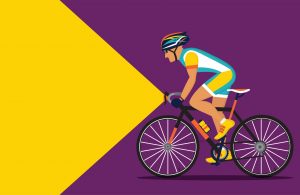Top 10 Recommended Bicycle Safety Gear
Request Free Consultation
Whether you choose to wear one or not, you probably know that a properly fitted helmet is by far the number one most important piece of safety equipment to protect yourself from injury when out for a bicycle ride. But what other safety gear is important and why? We compiled our list of the top ten things needed for bicycle safety.
10. First Aid Kit: Even if you are not going fast, if you fall off your bicycle, you are likely to sustain minor injuries such as road rash. It is important to get these wounds cleaned and covered quickly. Carry a first aid kit on your bike including bandages, gauze, antibiotic ointment, and butterfly closures.
9. Go-Pro or Dash Cam: In the latest year’s CDC statistics, there were almost 467,000 bicycle related injuries in 2015. 1 Often, bicycle crashes are unwitnessed and the only evidence available to resolve disputed liability cases is your recollection of the incident. Therefore, a camera attached to your bike or helmet can provide invaluable video footage to document what actually happened.
8. Tire pump, patch kit and spare tube: The most frustrating problem bicyclists face are flat tires. They always occur at the most inopportune place and locations – often far from your destination. If you are riding more than a few miles from home, a spare tube can replace tires with large punctures or blowouts. A patch kit may suffice to repair small punctures.
7. Mirror: There are many reasons bicyclists need to swerve abruptly into car travel lanes (e.g. a charging dog, a car door opening, a car pulling out from a driveway, a bouncing ball, road hazards). A mirror can help you know what’s behind you faster than a quick glance over your shoulder, which takes your eyes off the road and dangers in front of you. Mirrors may be attached to your handlebars or helmet. There are even sunglasses available with a mirror on the inside.
6. Bell or horn: If you can’t be seen, maybe you can be heard. When approaching pedestrians, runners, other cyclists, or even a car from the rear, sounding a bell can prevent collisions caused by unexpected motion coming into your riding path.
5. Reflective gear: Staying visible is the key to staying safe. Most accidents happen because a driver fails to see the cyclist. When it’s dark out, reflective gear helps other motorists recognize you and helps avoid the danger. Whether it be bright florescent colored jerseys or jackets, neon vests with reflectors, reflective stickers and bands, reflective lights, tires with reflective sidewalls, bright colored helmets, or reflective socks and shoes, there are many options to increase the likelihood that you will be seen and kept safe.
4. Cell phone, medical information, and ID cards: No one expects to be in an accident, but if you are, there’s no question you’ll wish you had these items. With your cell phone, you can call for help, be tracked by GPS, take photographs of the scene or get directions to the nearest medical facility. Cell phone holders help secure your cell phone to the bicycle so it can be easily located in the case of an emergency. If a bicycle crash renders you unconscious or incapacitated, it’s important to carry emergency identification and medical information including allergies, medication and past medical history.
3. Water: Staying hydrated is crucial to staying healthy and maintaining the function of every system in your body, including your heart, brain and muscles. 2 It may seem simple, but if you’re not properly hydrated before you ride and rehydrating on the road, you run the risk of dealing with serious side effects that could not only affect your performance, but also affect your health. Attach a water bottle cage to your bicycle and always bring a full water bottle. You may wish to consider adding an electrolyte infused drink mix to your water bottle for improved hydration.3
2. Headlight and rear reflector or flashing light: There’s a phenomenon known as “inattentional blindness”. It’s when people fail to notice an unexpected object in plain sight. Car drivers generally pay attention to other cars when driving. Driver’s brains are trained to look for two headlights or two rear lights. When drivers encounter bicyclists, motorcyclists and pedestrians, their eyes may see them, but their presence does not always register. That’s why it’s predictable that drivers may not see bicyclists and crash. If you ride with lights on your bicycle, it makes you that much more visible, even during the day. Illumination for nighttime or low light riding may seem obvious, but studies show that daytime lights can reduce bicycle accidents by 20%. 4
1. Properly fitted helmet: We cannot stress enough the importance of wearing a helmet while bicycling. In 2018, 61% of bicycle deaths occurred when the cyclist was not wearing a helmet.5 Sizes can vary between manufacturers, so take the extra time to follow the steps to fit your bike helmet – your life is worth it.
